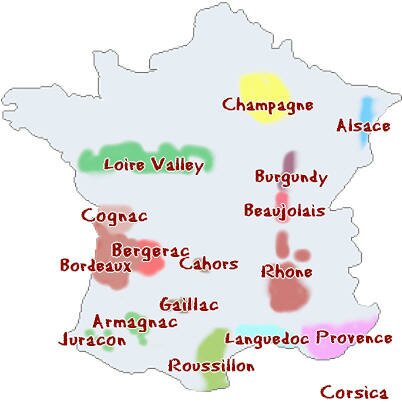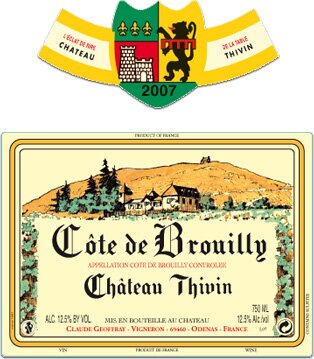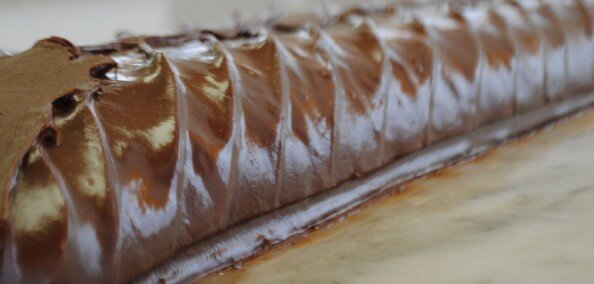
Author Archives: Todd Abrams
Wine Soak @ Signal-Return: Introduction to French Red Wine
It’s been a while in the making but a new Wine Soak event is finally here! We’re going to be drinking some kick-ass wines in a very cool space. Details are posted below.
http://www.eventbrite.com/
Wine Soak @ Signal-Return: Introduction to French Red Wine
When: 6:30 p.m. – 8:30 p.m., Thursday, April 25th
Where: Signal-Return – 1345 Division Street in Detroit’s Eastern Market
What’s the difference between the Loire Valley and the Rhone Valley? How is it that Languedoc-Rousillon produces a third of all wine in France yet you don’t see many bottles from this region on the wine store shelf? Why do some Burgundy and Bordeaux sell for hundreds of dollars a bottle? Does all Beaujolais smell like bubble gum? (No!) Can you find a good wine from any of these regions without taking out a loan? (Yes!)
We’ll explore these and other questions while hanging out and drinking at Signal-Return, a working letterpress studio that offers workshops and open studio time in the historic Eastern Market district. Our team of talented drinkers will select a specific red wine to represent each of six different regions of France: Beaujolais, Bordeaux, Burgundy, Languedoc, Loire, and Rhone. Each region will have its own short presentation, followed by open discussion.
If you’re hip to discovering new wine in a casual environment with a fine group of people, Wine Soak is where it’s at.
Wine Soak: Introduction to French Red Wine will be held on Thursday, April 25th at 1345 Division Street in Detroit’s Eastern Market. Doors open at 6:30 p.m. Presentations will begin at 7:00 and end at 8:30. Limited seating is available for the ridiculously low price of only $30 per person. Cost includes a pre-game glass of sparkling wine, 2 oz. pours of six different wines, and pizza from Supino Pizzeria.
Wine Soak is a wine tasting and discussion series designed for all levels, from novice to professional. Each event covers a different varietal, region, or theme, with a brief review of wine basics, sampling of six to eight different wines, and a rotating venue. No posing. No bullshit.
Special thanks to Southeast Michigan’s Premier Merchant of French and Spanish Wine since 1992, Elie Wine Company.
Chateau Thivin Cote de Brouilly: Why This $20 Wine is Better
I’m always trying to sniff out bottles of wine that supply the most gratifying drinking experience for the price. Some people call these “value wines”.
But it ain’t easy.
The vast majority of wine under $10/bottle is made to be consumed immediately and with little fanfare. In this price range you’re going to find a lot of idyllic back label stories that read like tourist guides to the Elysium Fields. The truth is — and here you can make an honest comparison to the realm of domestic beer — as many beer-only drinkers find their ice-cold American lager brand of choice to be a flawless beverage no matter what the situation, some wine drinkers will swear by $6 bottles of perfectly unremarkable chardonnay. That’s fine if you just want to catch a buzz.
At a local Indian restaurant that “allows” BYOB, I watched as a threesome were seated and one of their party subsequently pulled out a bottle of white zinfandel and two cans of Busch Light from his jean jacket. It seems to me that if you’re going to surrender your taste buds to the relatively exotic flavors of the Indian Subcontinent, you ought to at least have a simple Riesling or a malty Pilsener to wash it all down. This merely illustrates that most of the time familiarity rules — especially when the price is right.
You can find a wine with character for $10-$15. A value wine. One that pops into mind is Domaine de la Fruitière Chardonnay. Here is a dry, white wine that probably won’t change your philosophy but it does combine the richness of chardonnay with the crisp mineral structure of traditional Muscadet, and when slightly chilled, drinks agreeably in the shade of an oak tree near your favorite swimming hole on a warm July day. If you’re one of those aforementioned, strict chardonnay drinkers, here is a risk-free way to expand your palate.
If you are a wine enthusiast with a limited budget and a desire to learn, the $15-$25 range is ripe with good wine of character. This is your sweet spot. Unfortunately, there is also a lot of ordinary wine with large brand marketing budgets in this group. A trustworthy wine merchant is vital to lead the way here.
The trustworthy wine merchant is going to carry things like Château Thivin Côte de Brouilly for a little less than $25. But what makes this particular wine better? Why is it three times the price of Yellow Tail merlot?
The reasons are many. For one, it’s drinkable. I have consumed at least a half dozen bottles of this wine in the past few months with different people. With the exception of one person that was exceedingly sensitive to tannins, we all loved it. But drinkable does not mean simple. A glassful is all berries and flowers and wet stones. It’s tart and refreshing, with a minerality that grips at the finish. There is an integration of aromas, textures and flavors that elevate this wine well above the grocery store bottles. In short, it tastes like more than just fermented fruit juice.
Secondly, it’s from somewhere. Part of the pleasure derived from fine wine is creating a connection to a place. In this case we can identify it from the Beaujolais winemaking region of France. Further, it is from Brouilly, one of ten Cru Beaujolais, (the highest category of classification in the region). Even further, this wine is from vineyards in the sub-district of Côte de Brouilly, from the steep slopes of Mont Brouilly, where the soil is composed of volcanic blue stone. It’s kind of like one of those international espionage movies that zoom into a spot on earth from a satellite camera in orbit, except we witness a grape farmer tending his vines, not the assassination of a high level diplomat.
And finally, for the enthusiast, it’s educational. Compare this wine to other Cru Beaujolais in the same price range. Because all are made from gamay grapes, you begin to get a sense of how climate and soil can affect the finished wine (terrior!). And because Cru Beaujolais can sometimes develop over three to ten years, you can afford to let a few of these sit in the cellar and see how they change with time.
A typical question from wine novices when confronted with wine prices ranging from $3 to $300 is: Do you get what you pay for? I’ve struggled with this question myself after I decided I that I really, really like wine. A lot. And I still struggle. The general answer is complex and can include things like hand-harvesting, barrel-aging. Both of which are applied to Château Thivin Côte de Brouilly. So, in this case, I believe it’s a resounding yes. Buy some and invite me over for drinks.
Curious Foods of the North – Stories behind some of northern Michigan’s most popular fare.
Driving East on U.S. Highway 2 through Michigan’s Upper Peninsula between Naubinway and St. Ignace you are sure to see three things: a crystal blue Lake Michigan to your right, thick evergreen and hardwood forest to your left, and ahead, signs for pasties, smoked fished and fudge. How did these three distinct foods come to symbolize the north?
A Moveable Feast
Although regrettably sharing the same name as decorative nipple coverings, Michigan pasties are much tastier. Similar to pot pies but without the pot, these portable meals were a favorite of immigrants working Upper Peninsula mines before they were standard tourist fare.
Introduced in the 19th Century by Cornish miners, the hearty pasty could easily be eaten end to end, without knife or fork, and even reheated on a shovel held above a headlamp candle. Finns and Swedes, who were also working the mines, contributed their own culinary influences to the UP pasty.
The mining industry eventually collapsed but the UP pasty remained. Today, you can find pasties filled with chicken, fish, or simply vegetables. Some places will smother them in tomato sauce and melted cheese. You can even find them “Mexican style”.
The most satisfying UP pasty is filled with beef and diced vegetables (we like it with earthy, sweet rutabaga), has a solid crust, and comes with a cup of brown gravy on the side. It is best eaten on a chilly autumn day while the wind whips the Mackinac Straights into a white froth. A couple glasses of whiskey as digestif are optional though highly recommended.
Are You Calling Me a Fudgie?
The world is flooded with candy that has been processed and packaged in factories then shipped to corner convenience stores. But in Mackinac it’s old school copper kettles, marble tables, and sweet cream.
Every batch of fudge is handmade. When the syrup reaches what candymakers call the “soft ball stage” it’s poured onto marble and slowly manipulated with spatulas into logs. It’s said that this long cooling process, particularly during humid summer days, is what makes Mackinac fudge unique – its terroir, if you will.
True or not, this type of candymaking hearkens back to the days of people working with their hands and fits right into the wistful Mackinac Island experience where many a summer vacation memory has been made.
We prefer enjoying locally made fudge away from the throng of tourists in and around Mackinac. A short drive west is Wilderness State Park. Or head east to Cheboygan State Park. Both parks boast amazing forest and shoreline hiking opportunities. No better way to work off a giant hunk of fudge than a brisk few miles on foot, Bald Eagles soaring overhead.
Just Water, Salt and Smoke
It’s not so curious that a land and people surrounded by freshwater seas enjoy their fish. From Leland near the popular Sleeping Bear Dunes to remote Whitefish Bay to Houghton-Hancock and all points around and between, smoked fish finds its way into most every cabin in the northwoods.
Unlike thinly sliced lox that’s cold-smoked for preservation, northern Michigan fish are hot-smoked and thus the flesh is textured more like cooked fish. The process is simple. The fish, normally whitefish, salmon or trout, is brined in saltwater and placed in racks over smoldering logs. The wood used for smoking is often maple, another abundant local resource.
Though smoked fish can be made into a dip or even a sausage this classic northern Michigan dish is best enjoyed simply on a cracker. Pair it with a glass of crisp white wine, a lover, and the remains of a day gone orange behind the pines.
Drinking 2009 Jaboulet
Since the early 19th Century, Paul Jaboulet Aîné has been rocking folk’s taste buds with wine produced in France’s Rhône Valley. If you’ve ever browsed the French section of a wine store you’ve likely seen their Côtes du Rhône Parallèle 45, an entry-level southern Rhône blend of Grenache and Syrah.
But they built their reputation through parcels in the northern Rhône, Hermitage La Chapelle being the most famous. The 1961 vintage of Hermitage La Chapelle has achieved an almost mythical status among the wine cognoscenti (only $12k/bottle for those of you with a little extra disposable income).
Things weren’t as bright for Jaboulet through the 90s and into the new century. Production was up but quality was patchy. In 2006, the Frey family (proprietors of Chateau La Lagune in Bordeaux) purchased Jaboulet and applied sweeping changes that included a stricter selection process and significantly lower yields.
This is all just the long way of saying we hung out at Café Muse the other day and drank some 2009 Jaboulet with Elie. It was tasty.
My notes:
Châteauneuf du Pape “Domaine de Terre Ferme”
We started with the one southern Rhone in the bunch. Aromas of purple jelly led into wood smoke. Full body across the palate finishes long and herbal. This wine wanted to arm wrestle with me but I declined.
Côte Rôtie “Domaine des Pierrelles”
An elegant wine. On the nose there’s an initial hit of buttered toast and fruit compote that morphs into cedar and then flowers and then other lovely things our ancestors would know better than us. It somehow balances heft and grace like a ballerina that throws shot put as a hobby. All of the wines had plenty of acidity but it shone brilliant in this one, long and juicy. I’m writing this note a week later and I still get all tingly just thinking about it.
St. Joseph “Domaine de la Croix des vignes”
Fat with aromas of ripe fruit. Balanced across the center. There is weight here and also a long and dry finish sprinkled with powdery tannin.
Cornas “Domaine St. Pierre”
Immense nose of crushed berries and meat. Once you make it past the massive tannins a long and happy acidity shows. The provided tasting notes mention that you might want to cellar this monster for at least a decade before drinking. I believe those notes.
Crozes Hermitage “Domaine de Roure Rouge”
Heady aromas of stones, river banks, flowers, cedar closets, etc…all swirly and turning into steamed fruit and everything else. Fat, almost sweet through the middle yet finishes with a lively acidity. I can’t get my nose out the glass and I even save a bit for later sniffing.
Hermitage “La Petite Chapelle”
Nothing small about it. A dense and succulent drink of wine beneath scents of black currant liqueur and herbs.
Hermitage “La Chapelle”
If I counted off the aromas and flavors it would read like a French country village market shopping list including a side of beef. It is said that this wine will age 50 years. Grab a case and you might make your grandkids rich.
Lincoln Street
The first time I hung out at Lincoln Street Art Park was a couple of days before Halloween last year on a crisp autumn evening. The park’s founders were throwing a dedication party to celebrate the completion of the project’s first phase. We ate, drank, listened to tunes, and hung out around a pallet fire while the Amtrak Wolverine Service sped past a mere thirty feet away and a dazzling sundown filled the sky with orange and pink. It was a good day.
Subsequent impromptu bonfires saw us toasting ham and cheese sandwiches in a hobo pie maker or bidding farewell to winter by burning dried-up Christmas trees while Charley Marcuse, also known as Detroit’s singing hot dog man at Comerica Park, presented a speech rousing enough to complement the 20 foot high column of flames.
Pallet fires and trains and interesting people are enough to make a place appealing. At Lincoln Street, there’s also the art, from murals that cover entire walls to small ink drawings on random cinder blocks. There are graffiti tags, metal sculptures, stencils, and stickers. A frequent sightseer with a keen eye will find something new every time they visit. It’s a unique place, so I figured that more people should know about it and have the kind of fun I was having. With this in mind, Gourmet Underground Detroit organized our first event of the year – a late April potluck brunch.
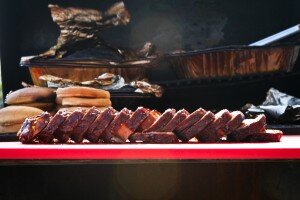 Those who were paying attention to the Facebook event page chatter would have thought that the potluck was going to be a meatfest. And it was: Bob Perye from Rouge Estate was on hand with his smoker and more pulled pork than we could eat. He came armed with four different homemade sauces to complement the tender pork. He was also serving decadent slices of pork wrapped pork wrapped in pork, aka “FrankenBacon”, provided by Tim Idzikowski of Detroit BBQ Company. John Schoeniger of Porktown was grilling sauerbraten sliders while sipping on a fine German weisse bier. And someone even brought a party pack of Cajun fried turkey wings from the nearby Turkey Grill. This place has been on my radar for a couple of years now, but the potluck was the first chance I’ve had to taste the wings. They did not disappoint.
Those who were paying attention to the Facebook event page chatter would have thought that the potluck was going to be a meatfest. And it was: Bob Perye from Rouge Estate was on hand with his smoker and more pulled pork than we could eat. He came armed with four different homemade sauces to complement the tender pork. He was also serving decadent slices of pork wrapped pork wrapped in pork, aka “FrankenBacon”, provided by Tim Idzikowski of Detroit BBQ Company. John Schoeniger of Porktown was grilling sauerbraten sliders while sipping on a fine German weisse bier. And someone even brought a party pack of Cajun fried turkey wings from the nearby Turkey Grill. This place has been on my radar for a couple of years now, but the potluck was the first chance I’ve had to taste the wings. They did not disappoint.
 Yes, there was an abundance of meat. But reflecting the diversity of Detroit, there was also plentiful vegetarian, vegan, and gluten free goodies. Assorted salads, pickles, savory tarts, guacamole, and sweets helped balance the spread. Everything was good, and I personally loved a simple cilantro, lime, and chickpea salad that spoke the language of a warm and sunny spring day in Detroit. Thanks to the generosity of Green Safe, there was no shortage of earth-friendly, compostable cups, plates, and utensils.
Yes, there was an abundance of meat. But reflecting the diversity of Detroit, there was also plentiful vegetarian, vegan, and gluten free goodies. Assorted salads, pickles, savory tarts, guacamole, and sweets helped balance the spread. Everything was good, and I personally loved a simple cilantro, lime, and chickpea salad that spoke the language of a warm and sunny spring day in Detroit. Thanks to the generosity of Green Safe, there was no shortage of earth-friendly, compostable cups, plates, and utensils.
As with any Gourmet Underground event, the libations were flowing. Evan Hansen revised a punch recipe to allow for single servings over ice that included three bottles of overproof rum. Assorted beer and wine was being poured from the tables, under the tables, around the tables. Towards the end of the day, the few of us that were still around and not wanting to let the day go were sipping Motor City Brewing Works hard cider with a float of corn liquor infused blueberries. Nobody went thirsty.
Lincoln Street Art Park won’t be mistaken for a typical suburban tract with plastic playground equipment and an acre or two of manicured lawn. Some rubble from the building that once stood on the lot still remains. A nearby hydrant has been leaking for so long that a small wetland habitat is growing around it and a sandpiper, typically a shoreline wading bird, has adapted to make Lincoln Street its home. It is the decaying Detroit that most of us know. But when the park is filled with the sounds of mirth, it is a Detroit that’s as alive as it ever was.
While we were cleaning up for the day and polishing off the last of that “City Billy hard cider spritzer,” Matt Naimi, in a moment of booze-fueled insight, best described Lincoln Street. He said, “we’re all just kids, and this is a great place to play.”
We dig Lincoln Street Art Park, and you should too. Show your love by voting for their proposed graffiti-style street art gallery in the Let’s Save Michigan Placemaking Contest.
We’ll see you at the 3rd Annual Belle Isle Potluck Picnic on Saturday, June 23.
RECIPES
Cilantro, lime, and chickpea salad
One 15-oz can chickpeas (2 cups cooked), drained and rinsed
2 cups spinach
1/4 cup sweet onion, chopped finely
Juice from 1.5 limes
3/4 cup fresh Cilantro
1/2 tsp sugar (or to taste)
2 tsp Dijon mustard
1 garlic clove
1 tsp extra virgin olive oil
1/2 tsp ground cumin
1/2 tsp kosher salt + ground pepper
Directions:
In a food processor, add the spinach and pulse a few times until chopped very small. Add the processed spinach, drained chickpeas, and chopped onion into a large bowl.
In the food processor (no need to rinse the bowl!), add the lime juice, cilantro, mustard, sugar, garlic, cumin, and oil. Process until smooth, scraping down the sides of the bowl as needed.
Pour the dressing on top of the spinach chickpea mixture and stir well. Add salt and pepper to taste. Let stand for about 10 minutes to let the flavors develop.
Bombay Government Punch (Hansen Remix)
3 bottles of Wray & Nephew overproof rum
3.5 quarts of cold-brewed Darjeeling tea
18 oz lime juice
16 oz demerara simple syrup
2 oz ginger syrup
Ideally, it’d be served on a block of ice so it slowly dilutes, and it’d go from being a bit too boozy and sweet to being pretty much perfect. But it was damn fine poured as single servings over ice.
April 29, Potluck Brunch at Lincoln Street Art Park & Sculpture Garden
Green stuff is growing, birds are fornicating, and thus our thoughts turn to eating and drinking outdoors in a hip place with interesting people.
Join us April 29th for a potluck brunch. Bring a dish to share, a few bottles of something to drink, and a chair to sit in if you wish. We’ll be making mirth from 12 – 5 p.m. and may even have a bonfire later in the evening if folks are still hanging out.
Take some time to explore the murals, sculpture, graffiti, and other forms of street art found on Lincoln Street (affectionately known as the Ghetto Louvre). A keen eye will find something in virtually every nook and cranny in the park and surrounding area, including the Recycle Here facility around the corner on Holden Street. It’s where creative talent inhabits the gritty landscape of post-industrial Detroit — truly a fascinating place.
Bring your friends, bring your kids, bring your friends’ kids, this potluck is open to everyone that wants to come. Hope to see you.
Link to the facebook event page
Wine Soak: Sauvignon Blanc
Gourmet Underground Detroit is pleased to announce Wine Soak: Sauvignon Blanc.
As the warmer months approach, our thoughts wander to breezy spring evenings and glasses filled with refreshing, white wine. We’ll explore the varietal, Sauvignon Blanc, from origins in France to its place in the New World.
Because Sauvignon Blanc is grown in so many regions, we’ll be able to travel a diverse wine path from dry to off-dry to sparkling. If you’re hip to discovering new wine in a casual environment with a fine group of people, Wine Soak is where it’s at.
 Wine Soak: Sauvignon Blanc, will be held from 8 until 10 p.m. on Saturday, April 14th at a private gallery in Ferndale. Limited seating is available for $30 per person. Cost includes a pre-game glass of sparkling wine, 2 oz. pours of six different wines, and an assortment of light snacks.
Wine Soak: Sauvignon Blanc, will be held from 8 until 10 p.m. on Saturday, April 14th at a private gallery in Ferndale. Limited seating is available for $30 per person. Cost includes a pre-game glass of sparkling wine, 2 oz. pours of six different wines, and an assortment of light snacks.
Wine Soak is a wine tasting and discussion series designed for all levels, from novice to professional. Each event covers a different varietal, region, or theme, with a brief review of wine basics, sampling of six to eight different wines, and a rotating venue. No posing. No bullshit.
Click this link to reserve your seat
Hippo’s — An Occasional Coney Dog Alternative
Ask any local what singular dish is quintessential Motor City snacking and their likely answer is the Coney dog. Whether you’re feeble with a hangover or just plain hungry for a big plate of unhealthy, there is nothing quite as satisfying as a natural casing hot dog slathered with beef heart chili, minced onion and yellow mustard in a spongy, white-bread bun. It’s a dog remarkably impractical to eat with your hands. In fact, if you can pick it up without making a mess of yourself, you might as well call it a chili dog.
But on the rare occurrence you might feel like a change, look no further than Chicago. Actually, Chicago is kind of far, so look no further than Rochester Road, slightly north of Maple, for a Hippo Dog.
 Hippo’s crafts an authentic Chicago-style dog. It starts with a steamed, Vienna Beef wiener resting in a poppy seed bun and then “dragged through the garden” by topping with mustard, onion, shockingly green sweet pickle relish, a dill pickle spear, tomato slices, sport peppers and a dash of celery salt. It’s a heady combination of soft, warm, comforting, crunchy and fresh. Don’t even think about ketchup. Save that for your fries.
Hippo’s crafts an authentic Chicago-style dog. It starts with a steamed, Vienna Beef wiener resting in a poppy seed bun and then “dragged through the garden” by topping with mustard, onion, shockingly green sweet pickle relish, a dill pickle spear, tomato slices, sport peppers and a dash of celery salt. It’s a heady combination of soft, warm, comforting, crunchy and fresh. Don’t even think about ketchup. Save that for your fries.
Like many of Chicago’s hot dog stands, Hippo’s is spare on the inside. Seating consists of a counter that runs along two sides of the building beneath large windows. Walls are adorned with accolades, signed photos of local news celebrities and nods to the Windy City. Bright yellow is the color scheme. During the busy weekday lunch hour, it’s not uncommon to see toolmakers rubbing elbows with mid-level executives. The cheerful staff is always ready with a greeting, and there’s a stack of newspapers near the door if you like to read a bit as you lean into your lunch.
In addition to a diverse menu of other styles of hot dogs (including the Coney), you can chomp a char-broiled Polish Hippo, Cajun sausage, Italian sausage, bratwurst, a Maxwell Street Polish sausage covered with grilled onions or a Chicago Avenue Polish sausage complete with sauerkraut and a pickle. Hippo’s has an entire library of tube steaks, most of which cost less than four bucks.
But the real draw is the classic Hippo dog for only $2.15. Being a Detroiter, there is no way I could ever admit that a Chicago-style hot dog is somehow superior to a Coney, though it is nice to have a place like Hippo’s around for an uncommon diversion.
Hippo’s is located at 1648 Rochester Rd. in Troy and a newer location at 35520 Groesbeck Highway, Clinton Township.
A Genuine Slice
Master pizzaiolo Dave Mancini’s move from a comfortable career as a physical therapist to serving what is arguably the best pizza in Detroit has been well documented. But it was no easy journey. It took hard work, passion, persistence, and an enduring love for the city to make it happen.
“You can’t hide behind the cheese”
What makes Supino pizza so good? It isn’t some flawless recipe handed down by Mancini’s Italian ancestors or discovered in an ancient Roman text. The secret to his success is nothing more than a focused effort to make the best possible pizza that he could. In fact, it took about seven years from the time he started making pizza to the eventual opening of Supino.
“I researched the shit out of pizza,” he says. To learn the business model, on his Saturdays off, he worked in a Birmingham pizzeria. He bought every recipe book he could find, even purchasing entire books for just one pizza recipe. After struggling with a few variables in the crust that he just couldn’t get a handle on, he did some consultation with a former pizzaiolo at Boston’s renowned pizza joint, Santarpios, until he got the consistency that he was looking for.
“A pizza is never really better than its crust. You can have amazing toppings and amazing sauce but if the crust is mediocre, the pizza is going to be mediocre.”
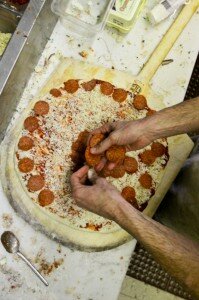 Regular patron and pizza aficionado, Phil Spradlin, tends to agree. He only orders his pizza with cheese because, as he tells Mancini, “You can’t hide behind the cheese.”
Regular patron and pizza aficionado, Phil Spradlin, tends to agree. He only orders his pizza with cheese because, as he tells Mancini, “You can’t hide behind the cheese.”
The question of style comes up more often than Mancini would care to address. “It cracks me up when I hear ‘New York-style pizza and New Haven-style pizza’, he says. “There are so many variations within those subgroups. Even between those two there is overlap. If you go to New York and get pizza at six different places, they are going to be pretty damn different. They’re not going to be Detroit-style, like Buddy’s, or Chicago-style. You can probably find those in New York but when people talk about New York-style pizza they aren’t pinning down a specific process. Most of them have a thin crust and are 18-inch pies but other than that, they’re kind of their own thing.”
He gets New Yorkers that come into the shop with a broad range of opinions. Some of them will tell Mancini that the pizza is just like home, some of them will tell him that it’s not really like home but it’s good enough, and some of them will tell him that it’s better than home.
Ask Mancini what style of pizza he makes and the short answer is “Dave’s style”.
Detroit Synergy
Local media make a big deal when celebrity chefs open upscale restaurants in Detroit. These successes certainly foster a positive perception of dining in Detroit, both locally and nationally. But it’s just as crucial – some would say even more so – for the resurgence of the city that small, independent establishments take root in their respective communities and be more than simply a place to eat good food.
For Mancini’s part, he’s doing what he can to help other promising food businesses by using their products and sometimes even opening his kitchen to them. You can order Katie’s Cannoli, hand-filled at the time of order so the shell stays crisp, for dessert. Porktown trades a portion of their sausage for use of his kitchen and Mancini purchases more for his pizza. The Asian inspired pop-up café, Neighborhood Noodle, operated out of Supino for a few of their monthly gigs.
 He seems almost embarrassed talking about the role he plays in this culture of cooperation, and believes he sometimes gets too much credit. Mancini recognizes that he’s certainly not the first one to think of mentoring other food entrepreneurs and is quick to praise those that have come before him and have helped him get his own business off to a strong start.
He seems almost embarrassed talking about the role he plays in this culture of cooperation, and believes he sometimes gets too much credit. Mancini recognizes that he’s certainly not the first one to think of mentoring other food entrepreneurs and is quick to praise those that have come before him and have helped him get his own business off to a strong start.
Like Jerry Belanger, owner of Park Bar, who would come in and order fifteen pies to hand out to his customers and give Supino a boost in its early days after opening. Spirited restaurateur Torya Blanchard helped to get Supino featured in Delta Sky Magazine. When Mancini decided he wanted to serve beer, Dan Scarsella of Motor City Brewing Works consulted with him, knowing the two businesses might be in direct competition.
Even neighboring Russell Street Deli would hand out menus to their customers during the lunch hour, apparently unconcerned about the possibility of losing customers. Mancini maintains that this cooperative culture “especially plays well in Detroit, because we’re underserved”.
He recalls the recent food truck gathering in Shed 2 of Eastern Market and how he was slammed with customers the entire time just because the event drew hordes of hungry people. Though some of his friends in the restaurant industry bristle about the possible competition with food carts, he believes that Detroit is a long way away from worrying about this kind of rivalry for the dining dollar.
Eastern Market on the rise
Eastern Market wasn’t the first location Mancini thought of when looking for a building to house Supino’s kitchen. It was only after an extensive three-year search, underscored by negotiations with indifferent landlords that had no interest in taking any risk by repairing the spaces they owned, that he “fell backasswards” into his current location.
Mancini finds far more advantages than challenges being based out of the Market district. Though all the buildings are old and there is always something that needs repair, that’s more than made up for by the steady foot traffic from the Saturday market, folks from downtown coming in for lunch on the weekdays, and other food workers in the neighborhood. “I think people with a good food idea are crazy not to jump into the Eastern Market area,” he says. He especially thinks that a good bistro and brewpub would do well there.
 Mancini has no plans to open a new location any time soon. He’s not the type to risk the quality of his product to cash in on its popularity. But there will be some changes this year.
Mancini has no plans to open a new location any time soon. He’s not the type to risk the quality of his product to cash in on its popularity. But there will be some changes this year.
He is consulting with local drinks authority, Putnam Weekley, to bring in a beverage program. Soon you’ll be able to order a beer or inexpensive glass of table wine chosen specifically to pair with the pizza. He also envisions a small, European-style bar with plenty of apertivi, digestivi, and a modest liquor selection. He speaks enthusiastically about Amaro CioCiaro, a bittersweet Italian liqueur produced in the same region as the town of Supino, Italy that he noticed one night while drinking at The Sugar House.
But instead of rushing to sell booze and maximize profit, he’s carefully planning how and what to introduce into the menu and ensure the core of his business stays healthy. While unsexy in comparison to a San Gennaro pie straight from the oven, all of this methodical planning and attention to detail is fundamental to Dave Mancini’s success, and makes certain that Supino will remain a fixture in Detroit for a long time to come.
Second Annual Detroit Holiday Food Bazaar
Don’t miss Detroit’s premier pop-up holiday marketplace featuring a variety of independent food vendors on Friday, December 9, 2011, from 5:00pm until 11:00pm.
In its second year of operation, the Detroit Holiday Food Bazaar has expanded and moved to the historic Eastern Market District. The list of vendors includes: Leopold’s Books, Love’s Custard Pie, Drought Juice, Detroit Institute of Bagels, Miette, Pete’s Chocolate Co., El Azteco, RG Distribution, Hugh, The Rogue Estate, Perkins Pickles, Beau Bien Fine Foods, Native Kitchen, Al Meida, Marvin Shaouni Photography, Great Lakes Coffee Roasting Company, McClure’s Pickles, Simply Suzanne, Suddenly Sauer, Corridor Sausage Co., Gang of Pour, and Porktown Sausage.
Not only is this a good way to support local small businesses and startups, you’ll have the opportunity to purchase some of the most finely crafted food products available in our city.
Ink it on your calendar and RSVP to their facebook event page.
Second Annual Detroit Holiday Food Bazaar
Friday, December 9, 2011
5:00pm until 11:00pm
2448 Market Street Detroit (above Cost Plus Wines)
